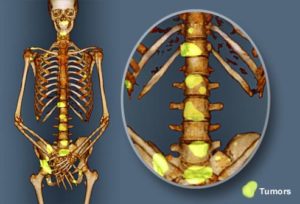
Recently Diagnosed or Relapsed? Stop Looking For a Miracle Cure, and Use Evidence-Based Therapies To Enhance Your Treatment and Prolong Your Remission
Multiple Myeloma an incurable disease, but I have spent the last 25 years in remission using a blend of conventional oncology and evidence-based nutrition, supplementation, and lifestyle therapies from peer-reviewed studies that your oncologist probably hasn't told you about.
Click the orange button to the right to learn more about what you can start doing today.
- You are here:
- Home »
- Blog »
- non-conventional therapies »
- Multiple Myeloma Lytic Lesions- Fractured Humerus, Help!
Multiple Myeloma Lytic Lesions- Fractured Humerus, Help!

I take all of these mentioned in the articles except calcium. You will not want to supplement with calcium depending on your own blood calcium levels.
Hi David- I am writing about multiple myeloma lytic lesions. I have had a bone fracture of my right humerus and the latest PET suggests the left one is in the same condition..
I sure would like to avoid that..I would appreciate any help with regard to bone health..
thanks. John
Hi John,
- Bisphophonate therapies (Zoledronic Acid, Pamidronate (Aredia), etc.)
- Denosumab-
- MM Survivor
- MM Cancer Coach
- Director PeopleBeatingCancer
Recommended Reading:
Exercise for Your Bone Health
Like muscle, bone is living tissue that responds to exercise by becoming stronger. Young women and men who exercise regularly generally achieve greater peak bone mass (maximum bone density and strength) than those who do not. For most people, bone mass peaks during the third decade of life. After that time, we can begin to lose bone. Women and men older than age 20 can help prevent bone loss with regular exercise. Exercising can also help us maintain muscle strength, coordination, and balance, which in turn helps to prevent falls and related fractures. This is especially important for older adults and people who have been diagnosed with osteoporosis.
The best bone building exercises
Weight-bearing and resistance exercises are the best for your bones. Weight-bearing exercises force you to work against gravity. They include walking, hiking, jogging, climbing stairs, playing tennis, and dancing. Resistance exercises – such as lifting weights – can also strengthen bones. Other exercises such as swimming and bicycling can help build and maintain strong muscles and have excellent cardiovascular benefits, but they are not the best way to exercise your bones.
Managing Osteoporosis: 9 Supplements and Vitamins You Should Consider
Food and Your Bones — Osteoporosis Nutrition Guidelines
Good-for-Your-Bones Foods
| FOOD | NUTRIENT |
|---|---|
| Dairy products such as low-fat and non-fat milk, yogurt and cheese | Calcium. Some dairy products are fortified with Vitamin D. |
| Fish | |
| Canned sardines and salmon (with bones) | Calcium |
| Fatty varieties such as salmon, mackerel, tuna and sardines | Vitamin D |
| Fruits and vegetables | |
| Collard greens, turnip greens, kale, okra, Chinese cabbage, dandelion greens, mustard greens and broccoli. | Calcium |
| Spinach, beet greens, okra, tomato products, artichokes, plantains, potatoes, sweet potatoes, collard greens and raisins. | Magnesium |
| Tomato products, raisins, potatoes, spinach, sweet potatoes, papaya, oranges, orange juice, bananas, plantains and prunes. | Potassium |
| Red peppers, green peppers, oranges, grapefruits, broccoli, strawberries, brussels sprouts, papaya and pineapples. | Vitamin C |
| Dark green leafy vegetables such as kale, collard greens, spinach, mustard greens, turnip greens and brussel sprouts. | Vitamin K |
| Fortified Foods | |
| Calcium and vitamin D are sometimes added to certain brands of juices, breakfast foods, soy milk, rice milk, cereals, snacks and breads. | Calcium, Vitamin D |



